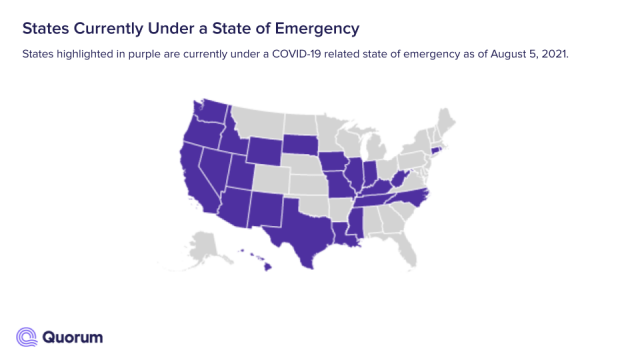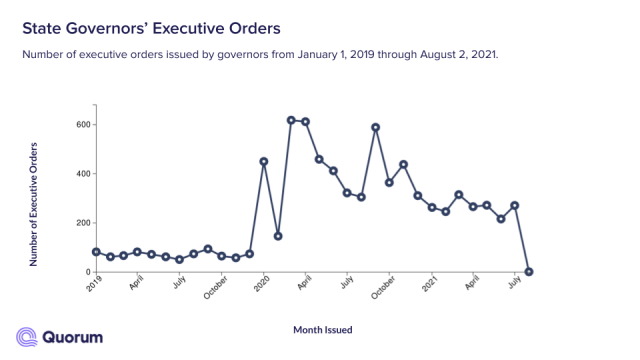With the COVID-19 pandemic came the unique rise in governors declaring states of emergency, expanding their executive powers, and therefore, their ability to issue mandates and update regulations related to the ongoing public health emergency. As vaccination rates increase, we may finally see the light at the end of the (very long) tunnel, but as of August 5, 2021 23 states are still currently under a state of emergency.
Under the 10th Amendment in the U.S. Constitution, states are granted any powers that fall outside of those specifically outlined for the federal government. In regards to the pandemic, this meant that state governors in some ways had more authority and power to fight the pandemic than the federal government did, giving them the power to mandate mask policies, close schools, and set business restrictions.
What exactly are state governors’ executive powers?
State governor executive powers include: enacting or vetoing legislation passed by the state legislature, declaring states of emergency, issuing executive orders, approving the state budget, and appointing state executive and judicial officials.
By declaring a state of emergency, governors are granted temporary powers that would otherwise be shared between the executive and legislative branches. This allows a governor to unilaterally issue executive orders without having to submit to the legislative process.
Executive orders and laws are different only in how they are enacted — both have the same enforceability once issued. Law is passed by the state legislature and sent to a governor for signature. When a governor declares a state of emergency, the legislature grants the governor the power to bypass this process and issue orders unilaterally.
Emergency gubernatorial executive powers and the COVID-19 pandemic
Brought on by the COVID-19 public health emergency, the role of governors became more important and more powerful — acting unilaterally to issue executive orders and absorb duties typically executed by state legislatures allowing for swift and decisive action to be taken to keep up with the rapid pace in which the pandemic evolved.
Some governors flexed these expanded executive powers more than others. Multiple factors went into the number of executive orders issued and the limitations each one outlined. Some state governors were more hands-off than others. New York Governor Cuomo issued 116 executive orders related to the COVID-19 pandemic compared to Texas Governor Abbott’s 31.
What the data says:
As of August 5, 2021, 23 out of 50 states are currently still under a state of emergency. As state legislative sessions don’t run year-round, making a state of emergency necessary to properly legislate against the pandemic without having to call a special session (risking gathering during the pandemic) to issue protective orders.

To put things in perspective, here is the month-by-month breakdown of executive orders from January 2019 through August 2, 2021:
With this increase comes the question, where do we go from here?
What a Governor’s Executive Power Means for Your State Affairs Strategy
As governors grow more comfortable issuing executive orders, pivot your lobbying efforts to state executive branches to maximize your reach. There’s no need to reinvent the lobbying strategy wheel here to set your team up for success. In fact, use the same strategies when working with the state executive branch as you do when working with state legislatures.
Lobby For Mandates the Same Way You Do Bills and Regulations
When meeting with a governor, gubernatorial staffers, or cabinet members, have your team members log interactions in Quorum the same way they would log an interaction with a state legislator or their staffers. Logging interactions help your team build and maintain institutional knowledge on what’s working, what isn’t, and allow you to flag if any follow-up is necessary.
Map Your Relationships with Governors, Cabinet Members, and Staffers
By mapping your relationships with state executive branch stakeholders (the governor, cabinet members, and their staffers) you can better track your engagement efforts. Map your relationships all year long so you can look back at the end of the year and evaluate how effective your team was at getting executive branch stakeholders engaged on your issue portfolio.
Engage in Private-Public Partnerships to Build Relationships with State Officials
Partner with public officials in the executive branch to build stronger relationships and invest in improving local communities. When the pandemic hit, Doordash partnered with state officials to use their platform to help small businesses stay open and coordinate a program that delivered excess food from restaurants to local food banks. They leaned on state officials to connect them with potential community partners for outreach. Doordash’s proactive efforts helped them build important symbiotic relationships with state officials. By initiating private-public partnerships to improve communities, you can better leverage those established relationships for future opportunities to collaborate.
The Future of State Governor Executive Powers
As the pandemic wanes and vaccination rates rise, there has been significant pushback against a governor’s ability to unilaterally rule under a declared state of emergency. In 2021 alone, 46 states have presented over 300 proposals aiming to diminish their governor’s executive powers with specific regard to closing businesses and schools and issuing mask mandates.
Some states have already limited gubernatorial powers since the beginning of the pandemic. In the 2020 election, Pennsylvanians voted to limit state of emergency declarations by their governor to just 21 days without the state legislature’s approval to extend. In Ohio, the state legislature overrode Governor Mike DeWine’s veto of a bill that grants the state legislature the power to overturn public health executive orders. The Michigan Supreme Court ruled that Governor Gretchen Witmer did not have the authority to extend states of emergency related to the COVID-19 pandemic.
